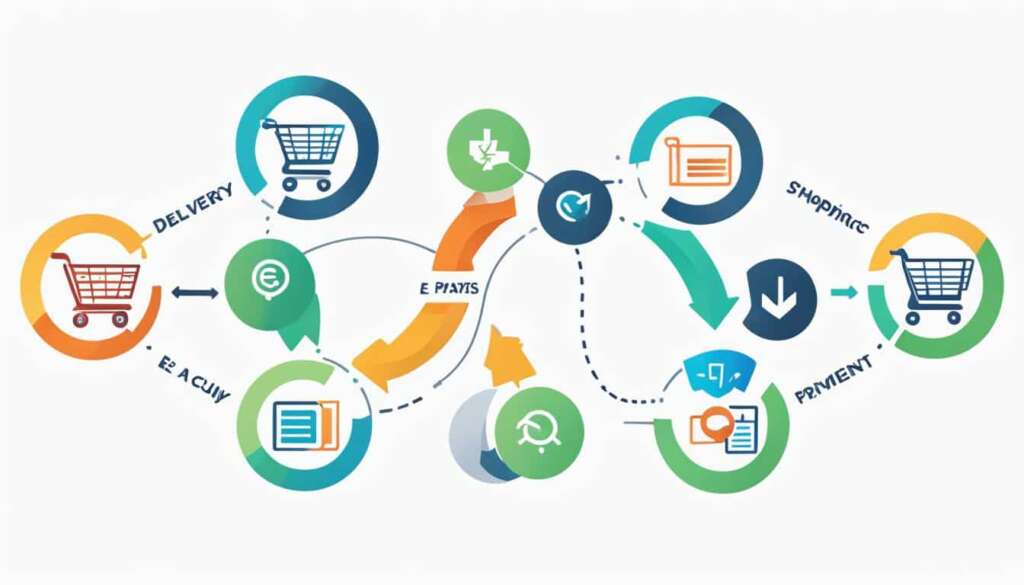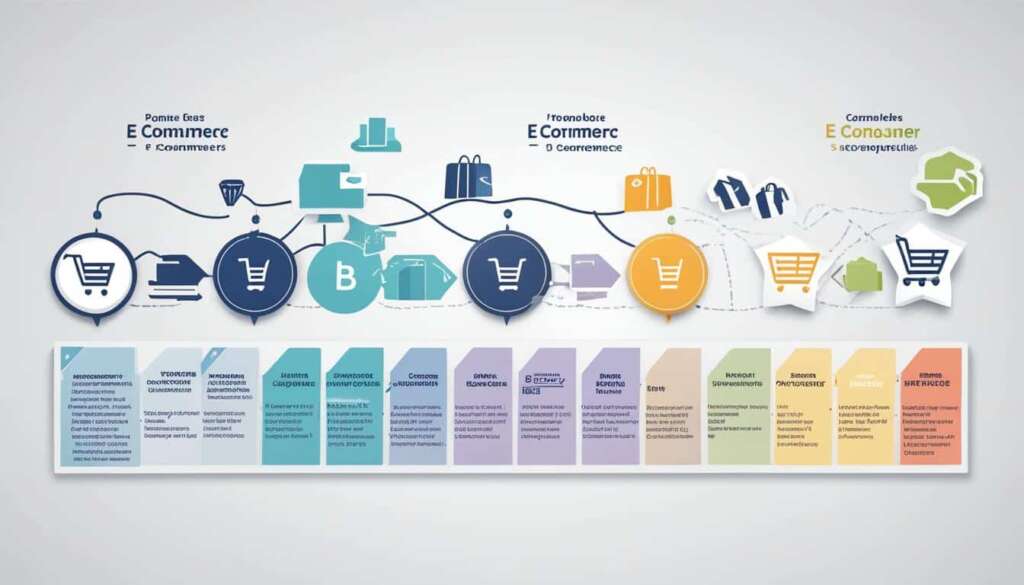Table of Contents
E-commerce, also known as electronic commerce, refers to the buying and selling of goods and services, as well as the transmitting of funds or data, over an electronic network, primarily the internet. It encompasses various types of transactions, including business-to-business (B2B), business-to-consumer (B2C), consumer-to-consumer (C2C), and consumer-to-business (C2B).
In recent years, e-commerce has experienced significant growth, with online platforms like Amazon and eBay contributing to its expansion. In 2011, e-commerce accounted for 5% of total retail sales, but by Q2 2020, it had reached 16.5% due to the COVID-19 pandemic.
E-commerce offers advantages such as convenience, accessibility, a wide selection of products, and international reach. However, it also has disadvantages, including limited customer service, the inability to touch products before purchase, and potential security issues. To fully understand the meaning and potential of e-commerce, let’s delve into its workings and various types of transactions.
How Does E-Commerce Work?
E-commerce, or electronic commerce, operates through the use of the internet to facilitate transactions between buyers and sellers. Customers utilize their own devices, such as computers, smartphones, and tablets, to access online stores and peruse a wide range of products and services. The process begins when a customer places an order, prompting their web browser to communicate with the server hosting the e-commerce website. The order data is then transmitted to various systems including inventory management, payment processing, and banking systems. Once the order is validated, the customer receives a notification indicating that their order has been processed. Subsequently, the order data is sent to the warehouse or fulfillment department to initiate the shipping or provision of services. E-commerce transactions transpire on diverse platforms such as online marketplaces, software as a service (SaaS) tools, and open-source tools.
Understanding the intricacies of the e-commerce process is critical for both buyers and sellers. This section will delve deeper into the mechanics of e-commerce transactions, exploring the various components and platforms involved. It will shed light on the underlying systems that enable smooth and reliable e-commerce operations. Additionally, it will provide insights into the types of e-commerce platforms commonly utilized by businesses and the advantages they offer in terms of accessibility, ease of use, and customization.
Key Stages of the E-Commerce Process
The e-commerce process consists of several key stages that ensure seamless communication and transaction flow between buyers and sellers. These stages encompass:
- Customer order placement
- Web browser communication with the e-commerce server
- Transmission of order data to inventory management, payment processing, and banking systems
- Validation of the order and notification to the customer
- Order data relayed to the warehouse or fulfillment department for shipping or service provision
By comprehending these stages, buyers and sellers can better grasp the underlying mechanisms that drive successful e-commerce transactions.
E-Commerce Platforms
E-commerce platforms serve as a crucial foundation for online businesses, enabling them to operate efficiently and effectively. These platforms provide the necessary infrastructure and tools for sellers to showcase their products, manage inventory, process payments securely, and track customer interactions. Some popular e-commerce platforms include:
| E-commerce Platform | Description |
|---|---|
| Shopify | A user-friendly platform that offers a comprehensive range of features, customization options, and integration capabilities. |
| WooCommerce | An open-source plugin for WordPress, providing flexibility, scalability, and a vast array of themes and extensions. |
| Magento | A powerful platform suitable for large-scale businesses, offering advanced features, scalability, and customization options. |
| BigCommerce | An all-in-one platform with robust features, seamless integration, and a focus on scalability and growth. |
These e-commerce platforms cater to the diverse needs of businesses, enabling them to establish a compelling online presence and drive successful e-commerce operations.
Types of E-Commerce
E-commerce transactions can be classified into different types based on the parties involved. Understanding these types is crucial for businesses looking to enter the digital marketplace and implement effective e-commerce strategies.
B2B E-Commerce
Business-to-business (B2B) e-commerce refers to the exchange of products, services, or information between businesses. In this type of e-commerce, companies engage in transactions with other companies, such as manufacturers selling raw materials to wholesalers or retailers purchasing inventory from suppliers. B2B e-commerce often involves larger order volumes and long-term business relationships.
B2C E-Commerce
Business-to-consumer (B2C) e-commerce involves businesses selling products, services, or information directly to consumers. This is the most common type of e-commerce that individuals encounter daily. B2C e-commerce includes online retail platforms like Amazon and traditional brick-and-mortar retailers with online stores. It allows businesses to reach a wider customer base and provide convenient shopping experiences.
C2C E-Commerce
Consumer-to-consumer (C2C) e-commerce enables individuals to trade products, services, and information directly with each other. Popular C2C platforms include eBay, Craigslist, and classified advertisement websites. C2C e-commerce allows individuals to sell their used items, handmade products, or services to other consumers, creating a peer-to-peer marketplace.
D2C E-Commerce
Direct-to-consumer (D2C) e-commerce is where businesses that manufacture or produce goods and services sell directly to consumers without intermediaries. D2C brands have gained popularity in recent years, leveraging social media, influencer marketing, and personalized shopping experiences to establish direct connections with customers. D2C e-commerce empowers brands to maintain control over their products, branding, and customer relationships.
Other types of e-commerce include consumer-to-business (C2B), business-to-administration (B2A), and consumer-to-administration (C2A). These types involve less common scenarios, such as individuals providing services to businesses (C2B) or individuals interacting with government entities (C2A). While less prevalent, they demonstrate the diverse nature of e-commerce and its possibilities.
Understanding the different types of e-commerce is essential for businesses to choose the most suitable approach and develop effective strategies that align with their target market and objectives. By leveraging the appropriate e-commerce type, businesses can optimize their online presence, enhance customer experiences, and capitalize on the vast opportunities offered by the digital marketplace.
| E-Commerce Type | Description |
|---|---|
| B2B E-Commerce | Exchange of products, services, or information between businesses. |
| B2C E-Commerce | Businesses selling products, services, or information directly to consumers. |
| C2C E-Commerce | Individuals trading products, services, and information directly with each other. |
| D2C E-Commerce | Businesses that manufacture or produce goods and services selling directly to consumers without intermediaries. |
| C2B E-Commerce | Individuals providing products or services to businesses. |
| B2A E-Commerce | Businesses interacting with government administration entities. |
| C2A E-Commerce | Individuals interacting with government administration entities. |
Advantages of E-Commerce
E-commerce offers several advantages for both businesses and consumers. Let’s explore the key benefits that make e-commerce a preferred choice in today’s digital landscape.
Around-the-Clock Availability
E-commerce benefits businesses and consumers by providing round-the-clock availability. Unlike physical stores with fixed operating hours, online stores are accessible 24/7. Customers can browse, shop, and make purchases at their convenience, breaking free from the constraints of traditional business hours. This flexibility enhances the overall shopping experience, allowing customers to make transactions whenever and wherever they want.
Wide Selection of Products and Services
Another advantage of e-commerce is the easy access to a diverse range of products and services. Online stores can offer a much broader selection compared to their brick-and-mortar counterparts. With just a few clicks, customers can explore various categories, compare options, and find precisely what they are looking for. This wide availability caters to diverse consumer preferences and enables businesses to cater to niche markets effectively.
International Reach
E-commerce breaks down geographical barriers, enabling businesses to sell their products or services to customers worldwide. The global nature of online platforms means that businesses can expand their reach beyond local markets and tap into a global customer base. This expanded market potential provides immense growth opportunities and the ability to reach customers in different countries, cultures, and time zones.
Lower Costs for Businesses
Operating physical stores comes with significant costs, including rent, utilities, staffing, and inventory management. E-commerce offers businesses the advantage of lower costs as they can avoid many of these expenses. By maintaining an online presence, businesses can streamline operations, reduce overheads, and allocate resources more efficiently. This cost-effectiveness is particularly beneficial for small businesses and startups, allowing them to compete with larger, established brands on a more level playing field.
Personalization and Product Recommendations
E-commerce platforms have advanced tracking and analytics capabilities that allow them to capture customer data and behavior. With this information, e-commerce sites can provide personalized product recommendations, tailor offers and promotions, and create a more customized shopping experience. By understanding customer preferences, businesses can enhance customer satisfaction and increase sales by presenting customers with relevant products or services they are likely to be interested in.
In summary, e-commerce offers a range of benefits for businesses and consumers. Its round-the-clock availability, wide product selection, international reach, cost-effectiveness, and personalized experiences make it an attractive option in today’s digital age.

Disadvantages of E-Commerce
Despite its numerous advantages, e-commerce also presents specific disadvantages and challenges that businesses and consumers must consider. These drawbacks can impact various aspects of the online shopping experience.
- Limited Customer Service: One notable disadvantage of e-commerce is the potential for limited customer service. Unlike physical stores, online businesses may have fewer support options or limited availability for addressing customer concerns and inquiries.
- Inability to See and Touch Products: Another significant drawback is that customers do not have the opportunity to physically see or touch products before making a purchase. This can potentially lead to unsatisfactory experiences if the products do not meet customers’ expectations.
- Shipping Wait Time: The wait time for product shipping is another disadvantage of e-commerce. Customers need to wait for their orders to be delivered, which can vary depending on factors such as location, shipping method, and order volume.
- Security Issues: Security concerns pose a challenge in e-commerce. Online transactions and personal information can be vulnerable to fraudulent websites and activities, requiring customers to exercise caution and take necessary precautions to protect their privacy and financial security.
- Higher Competition: E-commerce faces higher levels of competition due to the lower barriers to entry compared to traditional brick-and-mortar businesses. This increased competition requires businesses to constantly adapt, optimize their online presence, and find unique ways to stand out in the crowded digital marketplace.
Despite these disadvantages and challenges, the growth of e-commerce continues to redefine the way businesses and consumers interact in the modern marketplace. Recognizing and addressing these potential drawbacks can help both businesses and consumers navigate the world of online shopping more effectively.
How E-Commerce Drives Value for Retailers
E-commerce offers significant advantages and benefits for retailers, helping them unlock value and drive success in the digital marketplace. By leveraging efficient sales channels and creating alternative revenue streams, retailers can tap into the potential of e-commerce.
For smaller retailers, e-commerce presents valuable opportunities for growth and expansion. By embracing online platforms, these retailers can access a wider market and reach customers beyond their physical store locations. E-commerce allows smaller retailers to overcome geographical limitations and compete on a global scale, opening doors to new customers and increasing sales potential.
However, it’s important for retailers to be mindful of the challenges they may face in the e-commerce landscape. These challenges include: leading with a tech focus rather than customer experience, building a directionless tech stack without a clear strategy, underinvesting in necessary funds and capabilities, not fully understanding the business economics of e-commerce, and building too close to their existing core business without exploring new opportunities.
Larger retailers can also benefit from e-commerce by strategically launching new online businesses. By focusing on specific market segments or product categories, these retailers can create targeted e-commerce ventures that enhance their overall brand presence and diversify their revenue streams. Additionally, larger retailers can leverage their customer knowledge and partnerships with Retail Media Networks (RMNs) to build high-margin advertising opportunities for brands.
“E-commerce provides retailers with efficient sales channels and the ability to explore alternative revenue streams.” – [insert credible industry expert’s name]
E-commerce Value for Retailers – Stats and Insights
| Benefit | Insight |
|---|---|
| Increased Market Reach | By embracing e-commerce, retailers can sell to customers globally and access a broader consumer base. |
| 24/7 Availability | E-commerce allows retailers to cater to customer needs round the clock, providing convenience and accessibility. |
| Reduced Operational Costs | Physical store expenses can be significantly reduced, allowing retailers to allocate resources more efficiently. |
| Opportunities for Personalization | E-commerce platforms enable retailers to gather customer data and offer tailored experiences, leading to increased customer satisfaction and loyalty. |
How E-Commerce Drives Value for Brands
E-commerce has revolutionized the way brands engage with customers and unlock value in the digital landscape. By embracing the power of direct-to-consumer (DTC) channels, brands can tap into a myriad of opportunities to drive growth, build communities, and create unique shopping experiences.
DTC e-commerce enables brands to gain deep customer insights, as they directly interact with their target audience. By establishing a direct connection with consumers, brands can understand their preferences, purchasing behaviors, and pain points. This invaluable feedback empowers brands to refine their offerings, improve customer experiences, and develop personalized strategies that resonate with their audience.
But the value of e-commerce for brands doesn’t stop there. Emerging trends like live commerce and social commerce provide additional avenues for brands to thrive and drive value.
Live commerce combines entertainment and instant purchasing, offering consumers an immersive and interactive shopping experience. Brands can leverage live streaming platforms to showcase their products, engage with potential customers in real-time, and create a sense of urgency that drives conversions. The fusion of entertainment and e-commerce brings a new dimension of excitement, exclusivity, and convenience to the shopping journey.
Social commerce, on the other hand, harnesses the power of social media platforms to showcase products and facilitate seamless transactions. Brands can leverage the massive user base and engagement on platforms like Instagram and Facebook to promote their offerings, engage with customers, and drive sales. Social commerce blurs the lines between social interaction and online shopping, enabling brands to seamlessly integrate their products into the daily lives of consumers.
Both live commerce and social commerce offer brands unique opportunities to cut through the noise, capture attention, and establish meaningful connections with customers. The convergence of entertainment, social interaction, and e-commerce creates a powerful synergy that maximizes brand exposure, fosters brand loyalty, and drives bottom-line results.
With e-commerce as a driving force, brands have the ability to unlock exponential value, cultivate customer relationships, and stay ahead of the competition. By embracing DTC e-commerce, live commerce, and social commerce, brands can position themselves as innovative leaders in the digital landscape, delivering exceptional experiences that leave a lasting impression on consumers.

The Value of E-Commerce for Brands:
- Gain deep insights into customer preferences and behaviors
- Refine offerings and create personalized experiences
- Build communities and foster brand loyalty
- Engage customers through live commerce for immersive shopping experiences
- Utilize social commerce to showcase products and facilitate seamless transactions
- Establish meaningful connections with customers
“E-commerce provides brands with unprecedented opportunities to connect directly with their customers, cultivate relationships, and create unique shopping experiences.” – Brand Specialist
Conclusion
E-commerce has revolutionized the way we shop and conduct business. It has opened up new opportunities for retailers, brands, and consumers, providing unparalleled convenience, accessibility, and a vast array of products and services. The advantages of e-commerce are evident, as it offers around-the-clock availability and enables businesses to reach customers globally. However, it also presents challenges, such as limited customer service and the inability to physically experience products before purchasing.
Despite these challenges, the value of e-commerce for retailers and brands cannot be overstated. It offers efficient sales channels, alternative revenue streams, and the potential for remarkable growth and innovation. E-commerce has empowered smaller retailers to expand their reach and compete on a larger scale, while larger retailers have found opportunities to create new online businesses and enhance their existing offerings.
As e-commerce continues to evolve, companies must adapt and embrace its potential to succeed in the dynamic digital marketplace. With the right strategies and technologies in place, businesses can leverage e-commerce to connect with customers, provide personalized experiences, and drive value for both the sellers and the buyers. E-commerce is not just a trend or a passing phase – it is a fundamental shift in how commerce is conducted, and those who embrace it will position themselves for long-term success.
FAQ
What is e-commerce?
E-commerce, also known as electronic commerce, refers to the buying and selling of goods and services, as well as the transmitting of funds or data, over an electronic network, primarily the internet.
How does e-commerce work?
E-commerce relies on the internet to facilitate transactions between buyers and sellers. Customers use their devices to access online stores, place orders, and communicate with servers hosting e-commerce websites. The order data is then relayed to various systems, including inventory management and payment processing, before being sent for fulfillment or shipping.
What are the types of e-commerce?
E-commerce transactions can be classified into different types based on the parties involved. These include business-to-business (B2B), business-to-consumer (B2C), consumer-to-consumer (C2C), consumer-to-business (C2B), business-to-administration (B2A), and consumer-to-administration (C2A).
What are the advantages of e-commerce?
E-commerce offers advantages such as convenience, accessibility, a wide selection of products, and international reach. It also allows businesses to operate around-the-clock, personalize customer experiences, and track customer behavior for tailored recommendations.
What are the disadvantages of e-commerce?
E-commerce has disadvantages, including limited customer service, the inability to touch products before purchase, potential security issues, and longer wait times for product shipping. It also faces higher competition and requires constant adaptation and optimization.
How does e-commerce drive value for retailers?
E-commerce provides efficient sales channels and alternative revenue streams for retailers. It allows smaller retailers to access a wider market and offers opportunities for growth. Retail media networks (RMNs) also enable retailers to leverage their customer knowledge and provide advertising opportunities for brands.
How does e-commerce drive value for brands?
Brands can unlock value through e-commerce by establishing direct-to-consumer (DTC) channels. DTC e-commerce allows brands to gain customer insights, build communities, and directly interact with customers. Live commerce and social commerce are emerging trends that provide additional value by combining entertainment and social media platforms.
What is the summary of e-commerce?
E-commerce has transformed the way we shop and do business. It offers convenience, accessibility, and a wide selection of products and services. While it has advantages such as around-the-clock availability and international reach, it also presents challenges, such as limited customer service and the inability to touch products before purchase. However, e-commerce provides value for retailers and brands by offering efficient sales channels, alternative revenue streams, and opportunities for growth and innovation.







